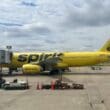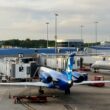Air Traffic Control (ATC) woes are stretching into their ninth day at Newark Liberty International Airport (EWR). The New York City area airport has been crippled with flight delays due to issues stemming from an outage on April 28, 2025 and show no signs of slowing down.

Air Traffic Control Loses Contact With Newark Bound Flights
On April 28, 2025, controllers were guiding aircraft into the airspace surrounding Newark Liberty International Airport, a major hub for United Airlines, when communications equipment crashed.
For roughly 30 seconds, controllers and pilots flying in the vicinity of the airport were unable to communicate with one another. Even though the outage seemed short, due to the congested airspace and the strain on the controllers, this caused a cascading effect of delays and cancellations. The delays have affected hundreds of flights and tens of thousands of passengers over the last nine days.
According to FlightAware, on Monday May 5, a full week after the initial incident, more than 150 flights to and from the airport had been cancelled while a further 350 were delayed. As the affects move into the ninth day, EWR is currently second on FlightAware’s Misery Map behind Dallas-Ft. Worth International Airport (DFW) which is experiencing severe weather.
Controller Shortage Compounds Issues
Anyone who follows aviation closely, meaning most readers of this site, knows that there is a massive shortage of air traffic controllers. The National Air Traffic Controllers Association, which represents roughly 11,000 controllers says the shortage is nearly the worst in the last 30 years with the number of controllers bottoming out in 2020 with the Covid-19 pandemic.
Scott Kirby, the CEO of United Airlines which operates a major international hub at Newark, addressed the issues in a memo to customers. While Kirby acknowledged that the technology used by controllers failed, he also claimed that the issues were compounded as “over 20% of the FAA controllers for EWR walked off the job.”
The controllers didn’t “walk off the job” but at least five controllers took the allowed 45 days of trauma leave after the incident. Controllers are able to take the leave if the experience a traumatic event, like the one we saw on Monday, April 28 when they were unable to communicate with 20 flights in the airspace surrounding Newark Airport.

The hiring and training of new controllers is a long process and the limits of who can be hired are stringent. New controllers must be under the age of 31 (there goes my career) to allow them to complete the 25 years of service to qualify for pensions before being force retired at 56.
Air Traffic Controllers and the system as a whole has been under intense scrutiny since the crash between an American Airlines regional jet and an Army Blackhawk helicopter killed all passengers and crew aboard both aircraft in Washington D.C. earlier this year.
Airlines Issue Travel Waivers for Newark Passengers
As a result of the cascading delays and cancellations, multiple airlines have proactively cancelled flights and offered travel waivers to customers. United Airlines, which is the largest carrier in Newark and operates flights to 76 different US cities and 81 international destinations, proactively cancelled 35 daily flights starting Saturday May 3rd.
United’s travel waiver spans flights scheduled to operate between May 6 and May 17 and allows passengers to rebook on flights from nearby LaGuardia Airport (LGA) in New York or Philadelphia International Airport (PHL) in Pennsylvania.
JetBlue goes even further, extending its waiver out through the end of the month, however it doesn’t allow passengers to use alternate airports.

Spirit, Delta, and American Airlines among others have not issued travel waivers or guidance for passengers traveling to or through Newark in the coming days even as delays show no signs of slowing down.
Summary
Air Traffic Control delays at Newark Liberty International Airport (EWR) have stretched into their ninth day as overworked controllers attempt to recover from a communications and equipment outage that occurred on April 28. Some airlines have offered travel waivers for passengers though we still have a long way to go before operations at the airport can return to normal.






